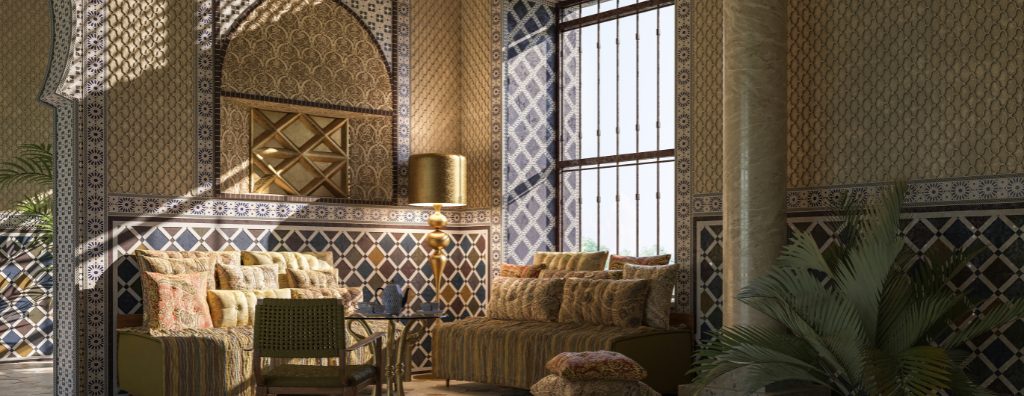For centuries, Morocco has captivated people from around the world with its rich tapestry of culture, art, and unmatched design. From the lively souks of Marrakech to the serene riads of Fes, Moroccan interiors tell a story of intricate craftsmanship, vibrant colors, and a blend of tradition and global influence.
In this post, we’ll look at the influences behind Moroccan design and explore how you can bring its distinct style into your home.
Influences of Moroccan Design
Moroccan interior design is rooted in ancient tradition and draws from various cultural influences, including Berber, Arab, Mediterranean, and Moorish. This fusion creates a warm, layered aesthetic that pairs detailed patterns with earthy textures and natural materials. You’ll often find colorful tilework, bold textiles, and handmade pieces that reflect centuries of artistry and heritage. And though this style is steeped in history, it remains timeless, seamlessly blending into modern homes while adding warmth, character, and a global touch to any space.
Key Elements of Moroccan Interior Design
Vibrant Colors
Moroccan design is synonymous with a vibrant and expressive color palette. Think of the dazzling blues of Chefchaouen, the rich reds and oranges of Marrakech, or the natural greens found in traditional gardens. Don’t be afraid to experiment with jewel tones like emerald green, sapphire blue, and ruby red, which you can balance with more neutral tones like terracotta, cream, and black to create a harmonious blend that pops. Even the most muted Moroccan room will feature a splash of something bold, whether in the tiles, lanterns, or layers of fabric.
Layered Textures
From olefine and wool rugs to carved wooden furniture and hand-woven baskets, texture is everywhere in Moroccan interiors. Plush, overstuffed cushions and floor pillows bring comfort to seating areas, while airy curtains soften windows and doorways. The thoughtful use of natural materials like clay, metal, leather, and stone gives each space a grounded, organic feel. This layered approach, combined with the intricate patterns and ornate detailing, provides a richness and depth that defines Moroccan design.
Mosaic Tilework
One of the most recognizable elements of Moroccan design is its stunning mosaic tilework, known as zellige. These hand-cut, geometric tiles are meticulously arranged to form intricate patterns that adorn walls, floors, and fountains. Each zellige piece is a testament to centuries-old craftsmanship, bringing a unique sense of artistry and a cool, refreshing feel to any space. Tiled floors are frequently layered with Persian or Berber rugs. At the same time, fireplaces, kitchen backsplashes, and bathroom walls may feature elaborate tilework that feels artistic and architectural. Incorporating zellige in your home, whether as a subtle accent or a vibrant statement, can instantly infuse an authentic touch of Moroccan design.
Riads and Courtyards
The word “riad” means “garden” in Arabic. In Moroccan architecture, a riad refers to a traditional home built around a peaceful interior courtyard. These courtyards are often the heart of the home, featuring tiled fountains, lush greenery, and shaded sitting areas. To replicate this feeling, consider making a designated “courtyard” area in your home by incorporating a small water feature, a collection of plants, and comfortable seating that fosters a sense of tranquility and connection to the outdoors.
Artisan Accessories
No Moroccan interior is complete without a variety of handcrafted accessories. From ornate brass lanterns and pierced-metal sconces to hand-thrown pottery and embroidered pillows, each piece tells a story that celebrates Morocco’s deep tradition of craftsmanship, giving your space a layered, lived-in feel that reflects both style and soul.
By bringing these 5 key elements into your home, you can create a space that feels soulful, timeless, and uniquely yours. For more design inspiration, tips, and trends, visit the design section of my blog.
 Facebook
Facebook
 X
X
 Pinterest
Pinterest
 Copy Link
Copy Link
